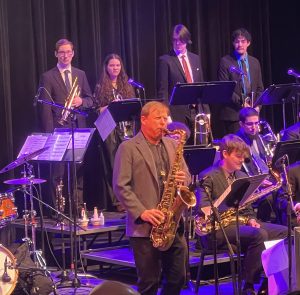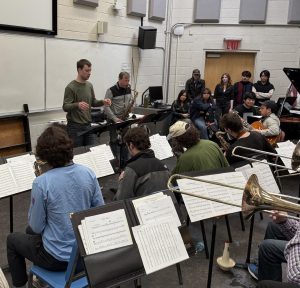Chris Potter “hated the saxophone growing up,” “[doesn’t] know how to practice,” and “[doesn’t] remember deciding to be a professional musician.” Now, he plays all over the world, and recently made a stop on campus.
No, these quotes are not from several decades ago; on Sunday, March 9, Potter took the Shea stage with the William Paterson Jazz Orchestra (also recognized as the big band) for the second Jazz Room Series concert of the semester.

Prior to the performance, jazz studies coordinator Dr. David Demsey hosted a well-attended interview with the special guest, who gave an insightful and honest retelling of his come up into the industry. First gigging when he was just 13 years old, Potter, now 54, has played and recorded with legends in and out of the jazz realm: Wayne Shorter, Pat Metheny, Steely Dan, and Herbie Hancock, to name a few.
In 2000, he received a Grammy nomination for Best Jazz Instrumental Solo, and in years following received accolades of “best tenor saxophonist” from numerous publications. But chasing recognition is not what keeps Chris playing. As he proclaimed, “there’s something that’s driving us all to do something besides just getting the rent paid.” To the non-musician, this may seem like an obvious statement. But committing to the unknown nature of gigging is a risky yet rewarding career to chase, especially as a jazz musician, which requires constant creating as opposed to performing written pieces.
This makes the craft a deeply personal art.
Although professionals like Potter may appear on award-winning records and tour with arena-booking artists, most full-time jazz musicians get their start by seeking one singular gig to the next. The jazz program at William Paterson is composed of 80 students, most of whom have already begun to chase this lifestyle. So why get a degree in music at all?
As Potter reflected on his time at the Manhattan School of Music, “the best thing about jazz school was being around other young musicians and having the experience of just listening to a bunch of music together that we’d never heard.” And thanks to the reputation of the program, students have opportunities like this one to receive advice from professionals– and to hear what it takes to get to that level. The concert began with trumpeter Thad Jones’ “Big Dipper”, the sporadic blowing of the jazz orchestra’s five-saxophone section foreshadowing Potter’s entry. Jones, who served as the first director of the jazz program back in 1973, donated the charts to the Living Jazz Archive, which is housed on campus in the Cheng Library.
After this ferocious beginning, Potter joined the big band to play his original titled “New Year’s Day,” a tune that creeps up behind you with what sounds like the pianist and drummer warming up, only to surprise you with an intense melody from the low growl of the baritone sax. The beginning feels like groggily waking up after a New Year’s Eve night spent partying too hard. This lingering theme, later transformed into a call-and-response battle with the trumpets, impresses a sense of uncertainty of what is to come and what came before. This sense of intrigue carried over into his next tune titled “Quick,” which begins with purposefully headache-inducing dissonance from the brass section.

While “New Year’s Day” conveys an energy of curiosity that makes you feel inspired to ask questions, “Quick” makes you want to put your foot down and demand answers. Right when the pressure got too high, Potter took a solo that addressed the intensity. He utilized pauses in his phrasing to give puzzled glances to the audience, feeding into the role of the weary voice of reason. After four more songs, three of which were arranged by jazz masters students, the concert concluded with “Abyssinia” (“I’ll be seein’ ya!” as Potter chimed). The final few minutes marched to the satisfying conclusion of a held-out chord.
It truly felt like the only point of resolution in the whole set, gratifyingly so. Tension has been diffused. Imaginary questions have been answered. Perhaps it could have been the dire tone set by “Big Dipper” that tricked my ears into hearing themes of urgency and answer-seeking throughout the set, but the more I thought about what Potter had shared in the interview, the more I realized that it was his music that masterfully paralleled his outlook on life as a whole.
With four decades of gigging behind him, Chris Potter is still discovering himself as a musician with the full humility that quite frankly, one just either is born with or isn’t. His lack of anticipating what his journey would look like is exactly what has done him wonders, and his music communicates this attribute.
When I asked him in the pre-concert interview what advice he’d like to give students, he made one thing very clear: “Have no expectations for what kind of remuneration is going to be involved…commit to just raising yourself to artistically the highest level that you can get.” The rest will follow.
As this modern jazz giant said about the music he’s dedicated his life to, “the improvisation is not just you improvising, it’s everybody making up whatever they’re gonna do and reacting, which I think is a great way of looking at life anyway.” Confident uncertainty is his muse.
![]()
Will Tansman • Mar 14, 2025 at 1:02 pm
Shyla – your review truly provided insight into the exciting music you heard and gave me extra interest in listening to more jazz, big band stuff! I really liked your word phrasing in describing the movement of the music- that was fun & great!